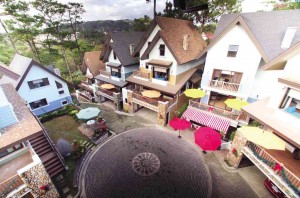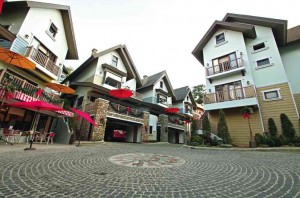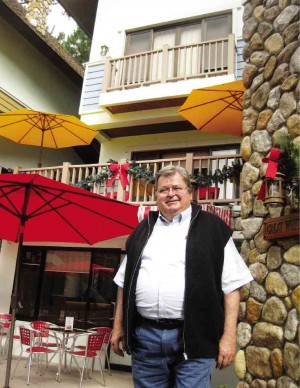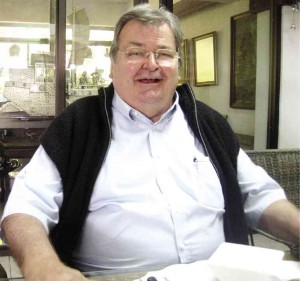In Baguio, German hotelier finds a home
BAGUIO CITY—Heiner Maulbecker has experienced much in his decades-long service as a hotelier in the Philippines, but nothing made him realize more the value of working with Filipinos than the 7.7-magnitude earthquake that shook Baguio in 1990.
The hotel he was then serving collapsed. He was in the thick of saving survivors and pulling out the injured and the dead (at least 80 employees were killed).
He said the main lesson the quake gave him was this: “If I ever should be faced with a natural disaster again, I hope I am surrounded by Filipinos. Filipinos jump right in. They immerse themselves and don’t wait for help from the outside world.”
His love affair with Baguio didn’t start out sweetly.
When he first made his way up in 1979, after he was appointed to professionalize the running of then Hyatt Terraces Baguio, which was losing money and taken over by Hyatt, he took Naguilian Road.
Kennon Road had been closed for two years. Marcos Highway did not yet exist.
He was at the wheel, the road was bad, it was a rainy day in October or November, and he had an Ilocano guide by his side.
The first thing he saw when he entered Baguio was the cemetery.
He thought, “We’re going up to hell!”
On Abanao Street, he saw a big billboard announcing a Fernando Poe Jr. movie with the actor pointing a submachine gun at pedestrians and motorists.
Before he was assigned to Baguio, Maulbecker had just finished a stint with Hyatt Bangkok.
Previously, he was with the Hilton chain, serving for 10 years in Frankfurt, Germany.
Istanbul was his last posting for the Hilton.
When Baguio was presented to him, he asked, “Where the hell is that in the Philippines?” He was assured it was “the Switzerland of the Philippines.” But when he finally got to Baguio, he said, “Switzerland my foot! This is like a hick town in the US!”
When he arrived at the Terraces, it looked “like a morgue. There were no guests, no light, no flowers, no life!”
The original owners built the hotel with no expert advice.
Its opening was timed for the World Bank-International Monetary Fund conference when there was a hotel-building boom and the government was generous with loans.
He stated in his report then that the hotel had too many employees, the payroll too high, the management nonexistent, and he couldn’t fire people.
He was there to make recommendations, which he promptly did so help could come fast. The goal was to make the hotel break even.
Prioritized were the chinaware, glasses, linen. He made a budget. Hyatt took it from there.
Renovations were done, an interior designer hired to give the rooms a uniform appearance.
New function rooms were opened to attract those holding seminars. Two cooks from Hong Kong and Japan were flown in to beef up the kitchen.
Maulbecker retrained people to level up to basic hospitality industry standards.
While changes were being made, he observed how “the Filipino employee is the best that you can have. With the proper training, you can bring the best out of them.”
He tapped Thelma Fullon, who had a Girl Scout leader background, as training manager.
He said, “She could do what I couldn’t—whack them behind the head or kick them in the back if they’re not doing well.”
His accomplishment was to turn a “derelict, sad-looking, lifeless hotel into a jumping, lively hotel.”
He also brought in Tippin Coscolluela since he couldn’t find a hotel person in Baguio who also had a national perspective and knew the Hyatt philosophy.
He connected with the people of Baguio through print and radio spots.
“But the best way,” he said, “was to bring them to the hotel.”
He formed an Executive Circle with membership cards that entitled them to monthly buffets.
There were Greek, German, Japanese nights followed by movie-themed buffets (The Great Gatsby, Wild Wild West, Tarzan) “until we ran out of countries to represent.”
Hyatt Terraces’ edge was it had “showmanship. We knew how to present food. When I attended functions here, food was just presented on aluminum foil, lechon was just chopped, chopped, chopped. That was it.”
For 10 years, the buffets went on.
He said, “The people appreciated it. All of a sudden, their response was, ‘Hyatt is our hotel.’”
Professional pride
He admitted though that “it wasn’t love at first sight. I hated it during my first year, but I saw the potential. There was a job to be done. My professional pride kicked in.”
When the work became more enjoyable, financial success followed. By then, he was also envisioning what would happen when the Americans left their US bases in the Philippines, including their R and R place, Camp John Hay.
There were meetings with the tourism secretary and other ranking officials. His message to them in behalf of his management team was: “Don’t worry, we can run that.”
The idea was to make John Hay, Poro Point and the San Fernando airport one operational unit.

UPPER House features cottages that can house 10-14 people each. RICHARD BALONGLONG/INQUIRER NORTHERN LUZON
Then President Fidel Ramos liked the idea of making Baguio the jumping point towards such destinations as the rice terraces in Ifugao and the beach resorts in La Union.
But because administrations come and go, the plan didn’t pan out.
Maulbecker rued, “It didn’t happen. It would’ve made us the center of tourism development in Luzon.”
Before he retired as The Manor’s managing director last year, he had these accomplishments under his belt: He opened the golf course while the hotel wasn’t yet ready, he opened the hotel followed by the CAP Convention Center.
Country boy
Baguio appealed to him because he’s a country boy at heart.
Born and raised in Heidelberg, Germany, he liked Baguio because “it’s like a neighborhood. I became friends with the mayor. Even if we argue, we’re still friends. Living in the Philippines is like organized chaos. But if you know how to live in chaos and survive, that’s the way to live.”
He recalled attending a Hyatt general managers’ meeting where he was the only guy without a problem.
“I was confident with my staff, I got along with the owners, I knew everyone from the city’s chief of police to the chief of the presidential staff. I learned how to tell the phonies and pretenders from the real guys. The other managers wanted transfers because their owners were a pain in the ass. Everyone wanted a transfer, except me,” he said.
He also personally knew the Presidents.
“They came up to play golf, and I’d have coffee with them. I remember having a conversation with President Gloria Macapagal-Arroyo about holiday economics. I told her she can declare Christmas four times a year!”
New challenge
Maulbecker hasn’t hung up his hotelier’s hat.
He loves a challenge, and he found another one in running the newly opened Upper House Village on 88 Paterno Street, South Drive.
Upper House features cottages that can house 10-14 people each. It acknowledges the trend among Filipino families of traveling in big groups once or twice a year.
“Hotels can’t cater to these groups, but our village can,” Maulbecker said. There’s a shift in the visitors coming up. The new and younger generation doesn’t know what Baguio is all about.”
He added: “It’s not like 30 years ago when everybody knew one another. Today they ask, ‘What can we do here?’ So we must offer more interesting things to do and see for them and these can be in the areas of culture, music, art, nature, fitness and wellness.”
Tribute
In his message at the recent tribute to him when he retired from The Manor, he said:
“This is not really a goodbye, as Baguio is my home. I think in the past life, I was bestowed with some of the wonderful Filipino blood which allowed me to make so many good friends, and also have such great working relationships. Being a hotelier for the past 52 years was not just a profession to me, but also a passion. It was sweat, blood, tears, courage and inspiration with dedicated long hours and sacrifice. It was teamwork, innovation, quick thinking and imagination.”
He closed with these words: “It is said, happiness is often more remembered than experienced. ‘One must wait until the evening to see how splendid the day has been.’ I knew then that I was happy, but didn’t know until now, how happy, how very happy I really was.”


